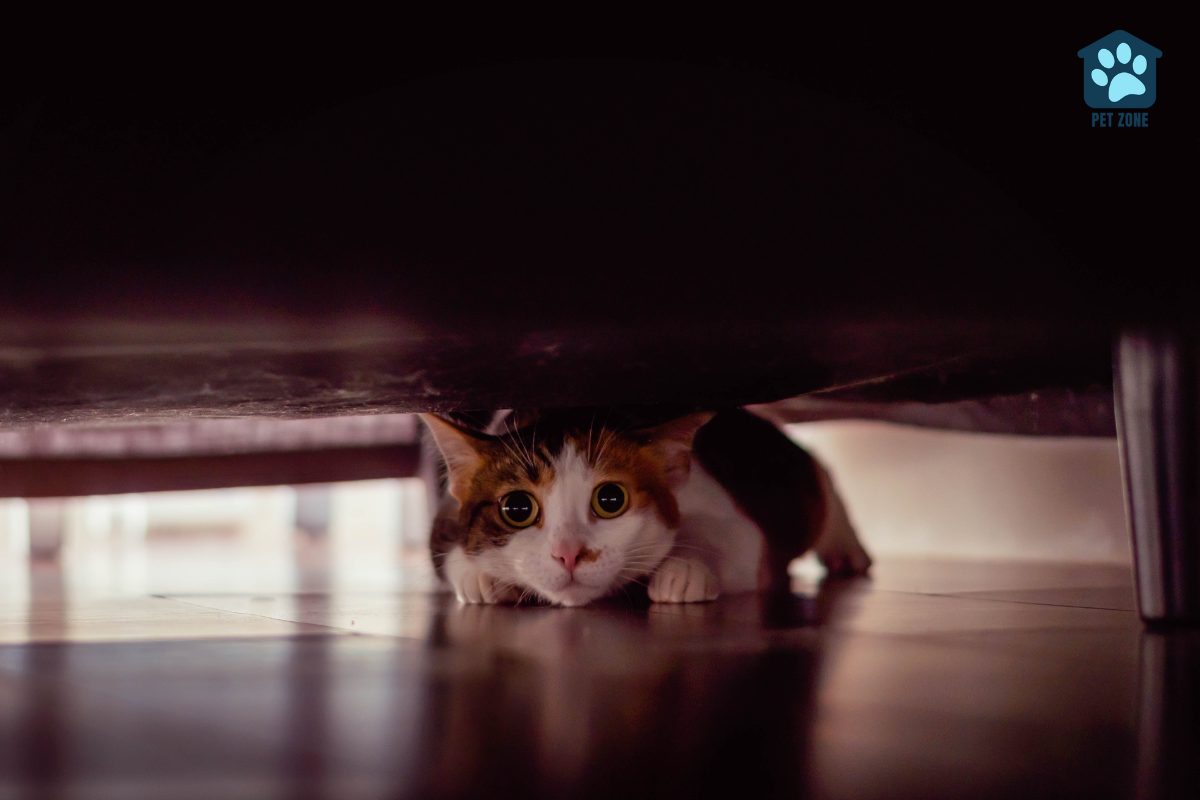Estimated reading time: 9 minutes
Cats are mysterious and often operate on their own terms, which can include hiding away in quiet corners of the house. Perhaps they’ve squeezed into a tight space under the bed or nestled behind a stack of boxes in the attic – either way, getting them out can be tricky.
One helpful fact for any concerned pet parent is that cats love cozy spots and may just be seeking comfort when they hide. But what do you do when ‘cozy’ turns into ‘I haven’t seen my cat all day’?
This article will guide you with gentle methods to coax your kitty back into view without causing any stress. We’ll cover understanding why cats hide and offer expert advice on encouraging them step by step from their secure nooks.
Key Takeaways
- Cats hide due to stress, fear, or illness. It’s important to give them time and space to come out when they’re ready.
- To coax a cat from hiding, create a calm environment, avoid loud noises and sudden movements, and ensure they have easy access to food, water, and their litter box.
- Use treats and toys to encourage your cat out of hiding. Reward them when they come out to reinforce positive behavior.
- Speak softly around your cat to help them feel safe. A gentle voice can ease their anxiety and build trust.
- Be patient with your hidden feline friend. Building trust takes time but helps make them feel secure enough to leave their hiding spot.
Understanding Why Cats Hide
Cats often seek out a hiding spot to deal with stress or fear. Loud noises, new environments, or even changes in the home can push a cat into hiding.
They might tuck themselves away in quiet corners, under beds, or any place that feels safe from what scares them. This behavior protects them from threats and helps them manage their anxiety.
If your cat is hiding more than usual, they might be feeling ill or uneasy. Sometimes a scared cat may refuse to leave its hideaway for hours or even days.
It’s crucial to keep an eye on these signs since health issues could be causing the discomfort leading to such behavior.
Remember not to rush your pet; give them time and space to emerge when they’re ready.

Tips to Encourage Your Cat Out of Hiding
Embarking on the journey to gently urge a feline friend from their secret refuge requires patience and understanding, but fear not—employing certain strategies can make this process smoother for both you and your whiskered companion.
Let’s explore nurturing ways you can influence your cat’s comfort level, creating an environment that naturally draws them out into the open where they feel secure and loved.
Allow Your Cat Time to Adjust
Give your cat time to get used to their new home. Some may hide for a few hours, others might take days. This is normal.
Keep calm and let them decide when they’re ready to explore. Don’t force them out of their hiding space. It can be scary for a new pet in an unfamiliar place.
Make sure your cat has easy exits from their hiding spots so they don’t feel trapped. They need the freedom to step out when it’s time.
Be patient and wait for your cat to feel safe enough to stop hiding on their terms. Your kindness will help your cat get comfortable faster.
Eliminate Potential Triggers
Look for things that scare your cat. Loud noises and fast moves can make a cat hide. Turn down the TV and move slowly to help your cat relax. Keep new people away at first so your cat won’t be scared.
Take away what makes your cat afraid. This might mean putting away items that cause noise or covering windows if outdoor activity upsets them. Make sure their space is quiet and safe, with no scary surprises popping out.
Create a Safe and Comfortable Environment
Place cozy beds and quiet spots around your home where your cat can hide without feeling trapped. Keep the space peaceful by avoiding loud noises and sudden movements.
Check that your cat has everything they need close to their hiding spot. Put fresh water, food bowls, and a clean litter box nearby so they don’t have to travel far when they’re ready to explore.
Give them the time and space they need to acclimate at their own pace without forcing them out of their safe zone.
Reinforce Positive Behaviors
Give your cat treats and playtime when they step out of their hiding spot. This shows them it’s good to come out.
Use their favorite toy to make the experience fun. They will start linking being visible with happy times.
Praise your cat in a soft voice whenever they leave their safe space. This makes them feel loved and brave.
Keep doing this, and soon your shy cat may become more social and confident.
Always be patient; trust takes time to build with a new kitten or scared cat.
Ensure Access to Resources
Make sure your cat can easily get to their food, water, and litter box. These resources should stay in the same place so your cat feels safe.
If they are hidden away, move them closer to your cat’s hiding spot. This way, they don’t have to go far to use them.
Place the carrier near your cat with some food inside. This helps the cat link the carrier with good things like mealtime.
Over time, this may encourage them to come out of hiding more often. They will start feeling more at home and less afraid of their new surroundings.
Keep feeding them tasty wet food in familiar spots so they feel comfortable moving around.

Expert Advice on Luring a Cat Out of Hiding
Navigating the delicate process of luring a skittish feline from its sanctuary requires more than just good intentions; it calls for a blend of patience, understanding, and strategic coaxing.
In the hands of experts, simple acts transform into powerful tools that are designed to build trust and make your hidden companion feel secure enough to emerge on their terms.
Building a Trusting Relationship
Building a trusting relationship with your cat is like growing a friendship; it needs time and gentleness. Cats, especially shy or scared ones, rely on feeling safe with you before they come out of hiding.
It’s all about being patient and not rushing things. Be around your cat often but keep your distance at first. Slowly spend more time near them without making sudden moves.
Talk to your cat in soft whispers to show you mean no harm. Sit down close to their hiding spot regularly, letting them get used to your presence. As trust builds, they might start peeking out to see who you are.
And remember, moving slowly helps the cat feel secure—it tells them there’s nothing to be afraid of when you’re nearby.
Using Toys and Treats
Toys and treats are your secret weapons to get a cat out of its hiding spot. Wiggle a feather wand near the entrance of where your furry friend is tucked away or gently roll a ball to rouse their curiosity.
Cats can’t resist the urge to pounce on things that move like prey. Try shaking the bag of treats — this sound often gets their attention. When they peek out, reward them with a tasty nibble.
Lure your cat with something irresistible like tuna or baby food placed near their hideout. The smell alone might be enough to coax them into the open. Always keep it fun and stress-free for them; let them associate emerging from their safe space with positive experiences only.
Don’t forget, that patience goes a long way in making your new cat feel secure enough to step out and explore.
Utilizing Calm Tone of Voice
Speak softly to relax your cat. A gentle voice can make a scared cat feel safe. When you talk to your hiding kitty, imagine telling a small child a bedtime story. Keep it soothing and full of warmth.
Your calm voice tells the cat that they are not in danger.
Use steady, soft words when you sit near the hiding spot. Avoid loud noises or sudden movements that could startle your cat even more. If you do this each time, your furry friend will learn to associate your quiet tone with safety and comfort.
This can help them come out on their terms, feeling secure and less fearful.

Conclusion
You’ve got the tips to get your scared cat out of hiding. A cozy spot, calm voice, and tasty treats work wonders. Remember, every cat is different; patience helps a lot.
Try these steps and watch your furry friend slowly come around. Your gentle approach will make them feel safe and loved!
Frequently Asked Questions
You can try luring your cat out with toys or food. Shake the bag of treats gently or put some cat food near their hiding spot. Give them time; cats need space and patience.
Let your new cat adjust at its own pace. Keep the space quiet and safe for your scared cat, so they feel secure enough to explore on their own terms.
When cats get scared or stressed, they may go into hiding. Think about any recent changes, like new faces or loud sounds that might have spooked your furry friend.
Yes, trying to force a fearful feline from its safe spot might scare it even more! Instead, let them come out when they’re ready – patience goes a long way.
Create a cozy environment with familiar items like their bed and toys — consistency helps build trust over time!
Start by associating your call with something positive — like eating food they love! Call them regularly during happy moments so that hearing you becomes comforting.
As an Amazon Associate I earn from qualifying purchases.










Great reminder that hiding can be from fear, not playfulness. Thank you!
My wife and I have 2 cats. 1 will come right out for a cat nip toy, the other will hide for days…
This is such helpful info! I have two cats and one tends to hide a bit more than another. I am curious what should a cat owner do if a cat hides due to a smoke detector or such going off where the noise scares them and it’s not stopping but you need to get them out of hiding to vacate? I’ve had this scenario happen a few times. Luckily it was false alarms and not real fires, but they got tucked away into tight corners that was very difficult to get them out of quickly.
My sister’s cat runs under the couch whenever I visit – I always assumed he just didn’t like me! I’ll try some of these tips (and not try to force him out) the next time I visit!